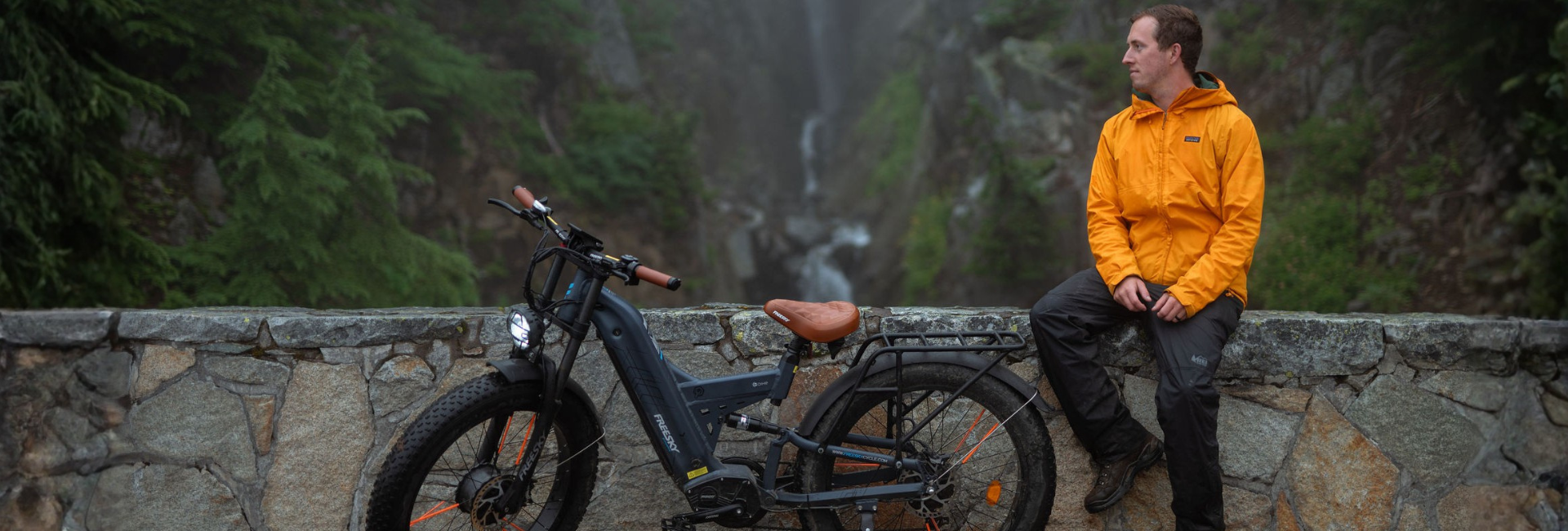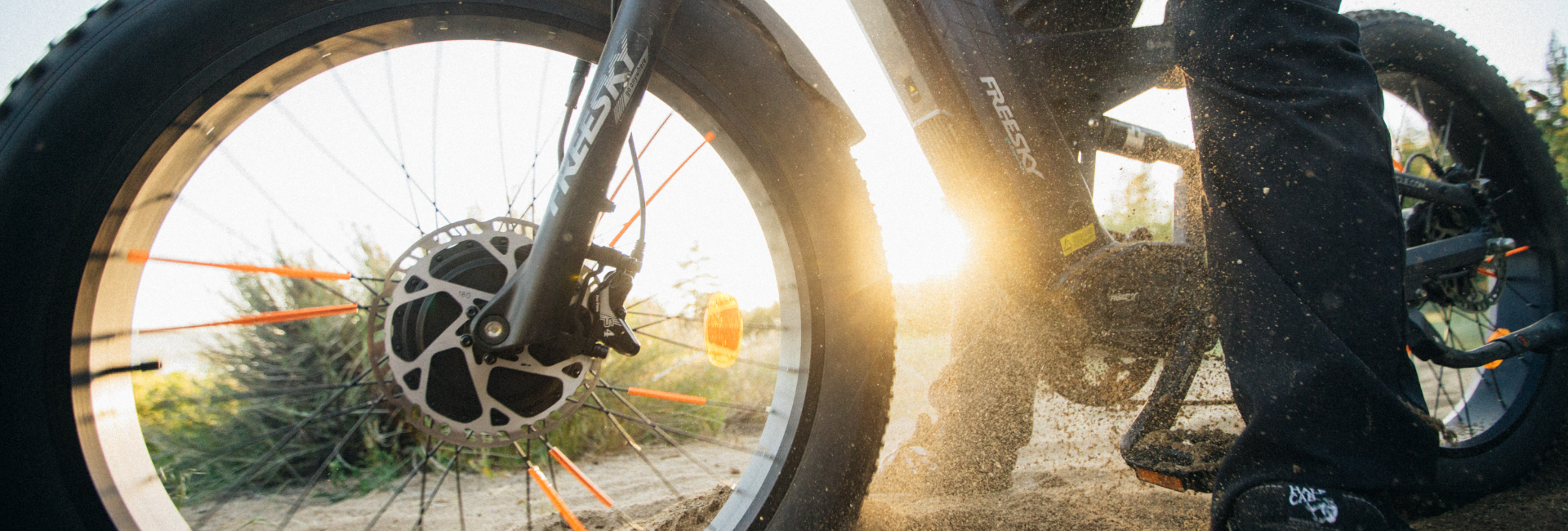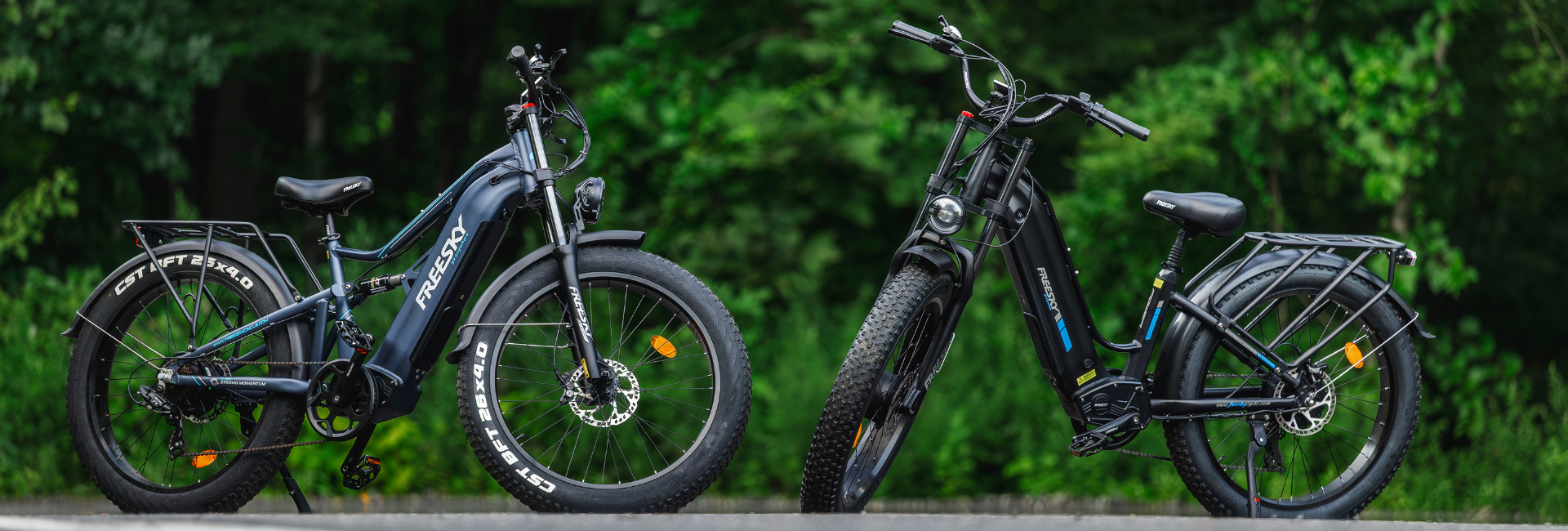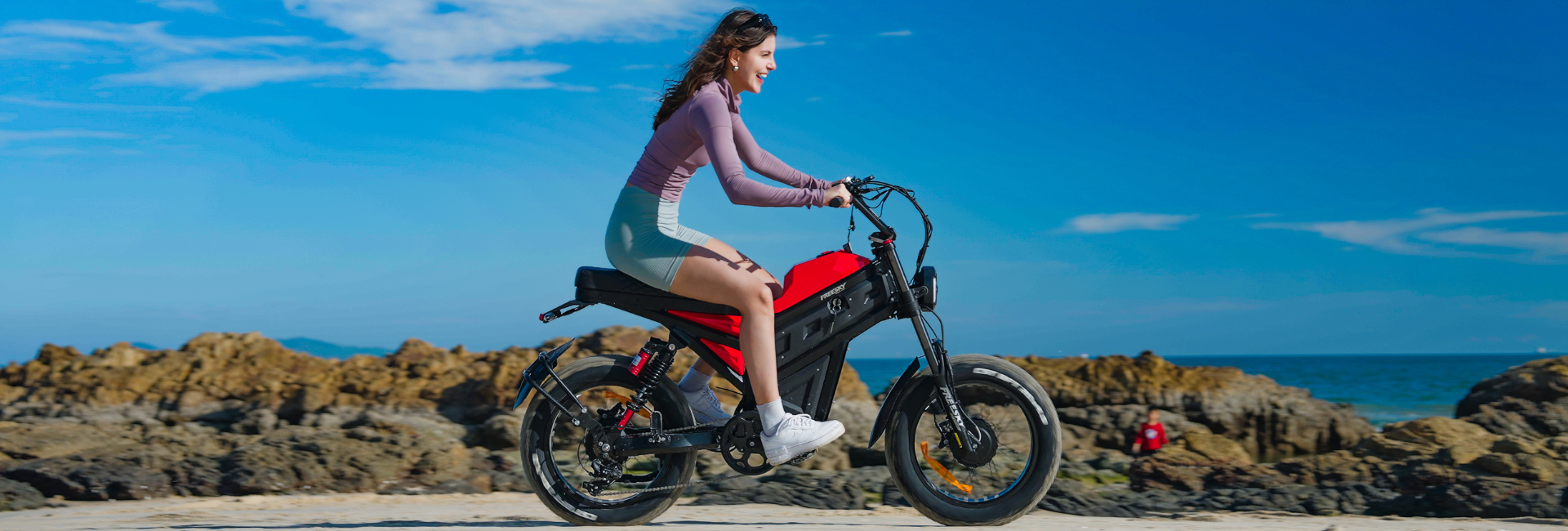FREESKY Blogs
Stay updated with the latest news, tips, and insights on e-bikes, technology, and sustainable riding through the FREESKY blog.
There's no item in your cart.
You May Also Like
You're Saving $0.00
Shipping, taxes, and discount codes calculated at checkout.All Topics


Dirt Bike vs E-Moped vs Electric Motorcycle: Key Differences Explained
Oct 27, 2025
As the electric mobility market rapidly grows, many riders wonder about the differences between dirt bikes, e-mopeds, and electric motorcycles. While they may look similar at first glance, each category is designed for distinct riding purposes, performance levels, and terrains. This guide will help you understand the differences and choose the right electric ride for your needs. 1. Dirt Bike Dirt bikes are primarily built for off-road and trail riding. Their key features include: - Lightweight frame and suspension optimized for rough terrain - Knobby tires for maximum grip on mud, sand, and loose surfaces - High-torque electric motor or gasoline engine - Single-rider focused design with limited comfort features Best for: Off-road trails, mountains, and adventurous terrain User preference: Riders seeking agility and thrilling off-road experiences 2. E-Moped E-mopeds combine motorcycle-style design with electric power. Key features include: - Upright seating position, comfortable bench for one or two riders - Throttle and pedal-assist modes for easy control - Motor power typically 250–1000W nominal, high-end models up to 2000W peak - Battery range usually 40–120 miles depending on model Best for: Urban commuting and short recreational rides User preference: Comfortable, daily-use friendly, low maintenance 3. Electric Motorcycle Electric motorcycles are designed for higher speeds and longer ranges. Their features include: - High-capacity batteries (1000Wh+), dual-motor or mid-drive systems - Top speeds often exceeding 50 mph, suitable for highways - Advanced suspension, hydraulic brakes, and full lighting systems - Heavier frame, but more stable and comfortable for long-distance rides Best for: Urban streets, highways, and long-distance travel User preference: High power, long-range, all-terrain capability Comparison Table: Dirt Bike vs E-Moped vs Electric Motorcycle Feature Dirt Bike E-Moped Electric Motorcycle Main Use Off-road trails, mountains City commuting, short trips City & highway, long-distance travel Motor Power 500–1500W electric or gasoline engine 250–1000W nominal, up to 2000W peak 1000–4000W peak dual motor Battery Range 20–60 miles 40–120 miles 100–200+ miles Comfort Basic, single-rider only High, upright seating, supports two riders High, full suspension, stable frame Top Speed 20–35 mph 20–35 mph (street-legal) 35–60+ mph Passenger Rarely Yes, tandem seat Depends on model How to Choose the Right Type - Off-road enthusiasts: Choose a Dirt Bike for agility, thrills, and trail-focused riding. - City commuting or casual rides: Choose an E-Moped for comfort, ease of use, and low maintenance. - Long-distance or all-terrain riding: Choose an Electric Motorcycle for high power, long-range, and dual-motor performance. Conclusion Dirt bikes, e-mopeds, and electric motorcycles serve very different purposes in terms of power, comfort, and riding scenarios. Understanding your personal riding needs is key to selecting the right vehicle. Cross-category models like the FREESKY Cheetah MT-380 Dual 2000W offer a blend of comfort, long-range battery, and powerful dual-motor performance, making them ideal for both urban commuting and light off-road exploration. Frequently Asked Questions (FAQ) 1.Can I ride an E-Moped off-road? Most E-Mopeds are optimized for paved roads. Limited off-road use may be possible, but dirt bikes or electric motorcycles are better suited for rugged terrain. 2.Is an Electric Motorcycle street-legal? Yes, as long as it meets local e-bike or electric motorcycle regulations. High-speed dual-motor models may require registration, a license, or insurance. 3.Does a Dirt Bike require a lot of maintenance? Off-road riding accelerates wear on tires, brakes, and suspension. Regular maintenance is recommended, especially for high-torque electric dirt bikes. 4.Which vehicle is the most energy-efficient? E-Mopeds and electric motorcycles are much more energy-efficient than gasoline motorcycles. E-Mopeds consume the least energy due to lighter weight and lower speeds.
Read More

How to Choose an Electric Bike for Mountain Adventures
Oct 24, 2025
There’s something profoundly liberating about venturing deep into the mountains—where the air is crisp, the trails untamed, and every climb rewards you with a breathtaking view. For outdoor enthusiasts, mountain adventures represent both challenge and serenity. But what if you could go further, climb higher, and experience more—all with less strain? That’s where electric mountain bikes (e-MTBs) come in. These powerful machines are revolutionizing the way we explore rugged landscapes. Whether you’re an experienced rider chasing adrenaline or a casual adventurer seeking new horizons, the right e-MTB can completely transform your mountain experience. So, how do you choose the best electric bike for mountain adventures? Below are five key factors to help you find a model that can handle steep climbs, rocky paths, and unpredictable conditions—all while delivering the thrill of the ride. 1. Battery Range and Capacity Battery life is the backbone of every e-bike experience, but it becomes even more crucial in mountain environments. When you’re miles from civilization, the last thing you want is to lose power halfway up a trail. For serious mountain riding, look for an e-bike equipped with at least a 48V 20Ah battery or higher. Premium models, such as the Troxus Warrior Pro or Alaska Pro, feature dual-battery systems capable of reaching over 150 miles per charge, giving riders the freedom to explore vast terrains without the anxiety of finding a power source. Terrain, rider weight, and assistance level all impact battery performance. To extend range, use eco or mid-assist modes on climbs and save full throttle for steep or technical sections. For multi-day expeditions, consider packing a spare battery or choosing a model with removable packs for easy swapping at your base camp. 2. Motor Power and Torque Mountain adventures demand muscle. Unlike flat city rides, you’ll face steep inclines, gravel, and uneven terrain—all requiring consistent power output. Look for an e-bike with a 750W or dual 500W motor setup. The dual-motor configuration offers exceptional torque and traction control, essential for navigating unpredictable trails and loose surfaces. For example, the Freesky Warrior Pro delivers 200Nm of torque, providing the climbing strength to tackle even the steepest gradients without sacrificing speed. A high-torque motor ensures smoother acceleration on technical climbs, while pedal-assist modes help conserve battery when conditions allow. Always verify that your chosen model complies with local regulations—some regions restrict motor power or throttle use on mountain trails. 3. Suspension and Frame Durability In mountain biking, suspension quality is the difference between a comfortable ride and a bone-rattling ordeal. A full-suspension e-MTB—with both front and rear shock absorbers—provides superior control and stability over rocks, roots, and descents. Choose frames made from 6061 aluminum alloy or carbon fiber for a balance between strength and weight. These materials withstand impact and vibration while maintaining agility on challenging terrain. If your adventures often involve technical trails or downhill rides, adjustable suspension systems are a must. They allow you to fine-tune your setup depending on terrain conditions—stiffer for climbing, softer for descending. 4. Tire Type and Traction The best e-MTB tires act as your first line of defense against unstable ground. Fat tires (4.0"–4.8") are ideal for mountain exploration because they provide enhanced grip, shock absorption, and flotation over mud, sand, or snow. When selecting your mountain e-bike, ensure the tires have deep tread patterns and puncture-resistant layers. Models like the Freesky Ranger combine durable fat tires with anti-slip design for maximum traction and stability. Pro tip: Adjust tire pressure based on terrain. Lower PSI (10–15) improves traction on sand or snow, while higher PSI (20–25) enhances control on rocky surfaces. 5. Weather Resistance and Protection Mountains are unpredictable—sunshine one minute, downpour the next. A reliable mountain e-bike must handle moisture, mud, and temperature swings. Look for a model with at least IPX5 water resistance, meaning it can withstand moderate rain and splashes. Protect the electrical components, especially the controller and display, with waterproof seals or covers when not in use. After each ride, wipe the frame dry and apply anti-rust spray to prolong durability. Riders who camp or ride for multiple days should also consider adding mudguards, chain covers, and waterproof panniers to safeguard both the bike and gear from dirt and moisture. In Conclusion The right electric mountain bike empowers you to explore farther, climb higher, and connect deeper with nature. Whether your journey involves rocky climbs, forest trails, or sunrise rides above the clouds, choosing a model with long battery life, strong torque, durable suspension, and weather protection ensures every adventure is as exhilarating as it is effortless. Electric bikes aren’t just machines—they’re your partners in adventure. So charge up, gear up, and get ready to conquer the mountains.
Read More

The Rise of Electric Bikes Transforming Urban Mobility for a Sustainable Future
Oct 20, 2025
Electric bikes are reshaping the way we move through our cities. Combining efficiency, convenience, and eco-friendly design, they are not just a trend—they are a revolution in sustainable transportation. This article explores the benefits of e-bikes, the challenges of adoption, and the future of this fast-growing mobility solution. Why Electric Bikes Are Becoming Essential Across the globe, electric bikes are quickly gaining traction among commuters, outdoor enthusiasts, and eco-conscious individuals. These versatile vehicles seamlessly combine pedal power with motor assistance, making them suitable for city streets, suburban commutes, and weekend adventures alike. The Versatility FactorImagine a bike that effortlessly adapts to your lifestyle: a reliable commuter during the week, a weekend companion for trail exploration, and a practical choice for running errands. Electric bikes offer this flexibility. Their motorized assistance allows riders to travel longer distances and navigate hills with ease, while still promoting an active, sustainable lifestyle. Health and Lifestyle BenefitsE-bikes encourage daily physical activity without overexertion. Pedal-assist technology helps riders gradually increase fitness levels, making cycling accessible to all ages and abilities. By integrating exercise into daily routines, riders improve cardiovascular health, reduce stress, and enjoy more outdoor time—all while reducing reliance on cars. Environmental Benefits of E-Bikes Cutting Carbon EmissionsE-bikes are an environmentally friendly alternative to traditional vehicles. With zero tailpipe emissions and low energy consumption, they help reduce urban air pollution and greenhouse gases. Choosing an e-bike for commuting contributes to a cleaner city environment and promotes sustainable mobility practices. Improving Urban Air QualityCities worldwide face growing challenges with air pollution. E-bikes provide a practical solution by easing traffic congestion and decreasing emissions. As their adoption increases, e-bikes contribute to cleaner air and healthier urban communities. Financial and Health Advantages Cost SavingsE-bikes offer significant financial benefits. Reduced fuel costs, lower maintenance expenses, and no parking fees make them an economical choice compared to cars or motorcycles. Over time, the savings can be substantial while simultaneously supporting environmentally responsible transportation. Boosting Personal Well-beingRiding an e-bike promotes low-impact physical activity. By blending exercise with motor assistance, riders gain cardiovascular benefits, improved mood, and reduced stress. E-bikes also make cycling accessible for longer trips and challenging terrains, encouraging a more active and balanced lifestyle. Tackling Barriers to E-Bike Adoption Addressing Range AnxietyModern e-bikes feature high-capacity batteries and efficient power management, allowing riders to travel longer distances without fear of running out of power. Understanding battery capabilities and proper charging habits helps riders confidently plan extended trips. Prioritizing SafetySpeed management, road sharing, and responsible riding are critical for safety. Wearing protective gear, following traffic laws, and maintaining the bike ensures safe and enjoyable journeys for all. Supporting Infrastructure and Policy Measures Infrastructure DevelopmentWider bike lanes, secure parking, and charging stations make e-bikes more practical and encourage adoption. Cities investing in e-bike-friendly infrastructure create safer, more convenient environments for riders. Government PoliciesSubsidies, tax incentives, and supportive regulations make e-bikes more accessible. Policies that integrate e-bikes into urban mobility plans help reduce congestion, improve air quality, and promote sustainable transportation. The Future of Electric Bikes Innovation in TechnologyAdvanced battery systems, faster charging, GPS tracking, and AI-assisted features are shaping the next generation of e-bikes. Future models may automatically adjust power levels based on terrain and rider behavior, providing an even smarter, more personalized riding experience. Mainstream AdoptionAs technology improves and infrastructure expands, e-bikes are becoming a practical alternative to cars and public transit. They offer a sustainable, cost-effective, and healthy transportation option for cities worldwide. Conclusion Electric bikes are more than a modern convenience—they are a pathway to sustainable, active, and efficient urban mobility. By combining environmental responsibility with health and lifestyle benefits, e-bikes represent a transformative solution for today’s cities. Embrace the e-bike revolution and join a movement that reduces carbon emissions, promotes active living, and delivers endless adventures. The future of urban transportation is electric—and it’s already here.
Read More

The Complete Guide to Electric Bike Care: Keep Your E-Bike in Peak Condition
Oct 17, 2025
Discover essential tips for maintaining your electric bike to ensure long-lasting performance. From battery care to tire management, these practices keep your rides safe, smooth, and enjoyable. Understanding Your E-Bike To maintain your electric bike effectively, you first need to understand its components. Most e-bikes share common elements such as a battery pack, motor, controller, sensors, display, and braking system. Knowing how these parts function helps you troubleshoot, perform routine care, and enjoy a smoother ride. Modern e-bikes often include pedal-assist features, powerful motors, and user-friendly displays for tracking speed, distance, and battery life. Motors are typically integrated into the hub or mid-frame, providing smooth power for climbing hills or cruising on flat roads. Lithium-ion batteries are standard, offering energy efficiency and long-term reliability, with either internal or removable placement options for convenience. Brakes, whether hydraulic or mechanical disc systems, ensure precise stopping power, while the drivetrain (chain, gears, derailleurs) directly affects pedaling efficiency. E-bike-specific tires are designed to handle higher weight and torque, improving stability, grip, and comfort across various terrains. Accessories such as lights, fenders, and racks further enhance usability, while ergonomic saddles, grips, and bike computers improve overall riding experience. Cleaning and Visual Inspections Regular cleaning prevents corrosion, identifies potential issues, and keeps your e-bike operating smoothly. Use a soft brush, mild detergent, and water, avoiding excessive moisture near the battery or motor. After washing, inspect: - Frame: Check for scratches, dents, or corrosion. - Wheels and tires: Look for debris, cuts, or bulges. - Brakes: Verify pad thickness and even wear. - Electronic components: Ensure connectors are dry and dust-free. Test ride the bike and listen for unusual noises or vibrations. Early detection of minor issues prevents costly repairs and maintains your e-bike's efficiency and safety. Battery Care and Charging Tips Your battery is the heart of your e-bike. Proper maintenance enhances both safety and longevity: - Optimal Charging: Keep the battery between 20–80% charge. Avoid deep discharges or constant full charges. - Storage: Store indoors at room temperature, away from sunlight and extreme conditions. - Cleaning Contacts: Regularly wipe battery contacts with a dry cloth to prevent corrosion and ensure proper connectivity. - Follow Manufacturer Guidelines: Adhere to specific charging and care instructions for your battery model. Preventing Battery Hazards Battery safety is paramount: - Use Approved Chargers: Avoid incompatible chargers to prevent overcharging or overheating. - Supervise Charging: Never leave the battery unattended for long periods; monitor for overheating. - Proper Storage: Avoid extreme temperatures; store in cool, dry places. - Regular Inspection: Check for cracks, swelling, or leaks; replace damaged batteries immediately. - Safe Disposal: Recycle lithium-ion batteries through certified facilities. Drivetrain and Gear Maintenance A well-maintained drivetrain ensures smooth power transfer and prolongs component life: - Clean and lubricate the chain regularly. - Inspect gear cogs and derailleurs for wear or misalignment. - Proper adjustment enhances riding comfort, reduces battery drain, and prevents costly breakdowns. Brake Upkeep Brakes are crucial for safety: - Inspect pad thickness regularly; replace if below 1.5mm. - Bleed hydraulic brakes annually; mechanical brakes require routine checks. - Well-maintained brakes ensure reliable stopping power and rider confidence. Tire Care and Management Tires are the only contact with the road, so proper care ensures stability and safety: - Pressure: Maintain recommended PSI for comfort and grip. - Inspect for Debris and Wear: Remove sharp objects, monitor tread, and check for sidewall damage. - Repair Skills: Learn to patch or replace tubes to stay independent and prepared. Conclusion Electric bike maintenance may seem tedious, but it is essential for safety, efficiency, and durability. Routine care saves money, prevents breakdowns, and ensures a smooth riding experience. With consistent attention to your e-bike’s battery, brakes, drivetrain, tires, and electronics, your electric bike can deliver safe, efficient, and enjoyable rides for years. Explore your world sustainably and confidently, knowing your e-bike is in top condition.
Read More

How Long Do Electric Bikes Last? A Complete Guide to E-Bike Lifespan and Maintenance
Oct 13, 2025
Electric bikes have become a popular, eco-friendly, and convenient way to travel. Combining the mechanics of traditional bicycles with the power of electric motors, e-bikes offer a smooth, assisted ride. But one question many riders ask is: how long do electric bikes actually last? Understanding your e-bike’s lifespan is essential. It helps you plan future costs, maintain your bike properly, and get the most value from your investment. In this guide, we break down everything you need to know about e-bike longevity, maintenance, and replacement parts. What Determines an E-Bike’s Lifespan? An e-bike’s lifespan depends on the quality of its components, how you ride, and how well you maintain it. At FREESKY, we build our bikes with premium components to ensure long-lasting performance. For example: - Frames are made from 6061-T6 aluminum or carbon fiber, both lightweight and corrosion-resistant. - Motors are IP65-rated, protected against dust and water. - Drivetrains, chains, and brakes use stainless steel or high-quality materials to withstand years of use. While quality materials help, the lifespan also depends on usage and maintenance. Key Components That Affect E-Bike Longevity 1. Battery Life The battery is the heart of any electric bike. Most e-bike batteries last 500–1000 charge cycles before their capacity declines significantly. Depending on your riding habits, this usually translates to 3–5 years of use. Tips to Extend Battery Life: - Avoid running the battery down to 0%. - Charge between 20% and 80% instead of always fully charging. - Store the battery in a cool, dry place when not in use. FREESKY batteries are designed for durability and long-term performance, giving riders reliable range for years of commuting or adventure. 2. Motor Durability The motor converts battery energy into motion. A quality e-bike motor can last 10,000 miles or more with proper care. To ensure longevity: - Keep the motor clean and free of debris. - Avoid overloading the bike beyond its intended weight. - Follow manufacturer guidelines for regular maintenance. 3. Frame and Build Quality A strong frame supports the entire bike. Aluminum, steel, or carbon fiber frames can often outlast the electrical components of the bike. With proper care, a high-quality frame can last decades. How to Maintain Your E-Bike Regular maintenance is key to extending your e-bike’s lifespan. Here’s what you need to do: 1.Routine Check-Ups - Tighten bolts, inspect brakes, and maintain proper tire pressure. - Clean and lubricate chains and gears to prevent wear. - If needed, have a local bike shop perform a full tune-up. 2.Proper Storage - Keep your e-bike in a dry, cool place. - Avoid leaving it in extreme heat or cold. - For long-term storage, remove the battery and keep it partially charged. 3.Smart Riding Habits - Avoid rough terrain or overloading your e-bike. - Use pedal assist wisely to reduce strain on the motor. - Treat your bike gently during transport. Parts Replacement and Upgrades Over time, certain components will need replacement or upgrades: - Brake Pads, Tires, Chains – These wear with normal use and should be inspected regularly. - Batteries – Replace after 500–1000 charge cycles or if capacity drops noticeably. - Motors – Unusual noises, reduced power, or malfunction may indicate it’s time for service or replacement. Upgrading to higher-quality parts can improve performance and extend the overall lifespan of your e-bike. Factors That Can Shorten E-Bike Lifespan - Neglecting Maintenance – Dirt, rust, and worn components can damage other parts. - Extreme Weather – Excessive heat, cold, or moisture can damage batteries and electronics. - Improper Use – Overloading, aggressive riding, or ignoring manufacturer guidelines accelerates wear. How Long Will Your E-Bike Last? With proper care and maintenance, a well-built e-bike like FREESKY can last 3–10 years or more. Batteries, motors, and other replaceable parts determine long-term performance. Investing in quality components and original replacement parts ensures a safe, reliable, and durable e-bike. Conclusion: Protect Your Investment To maximize your e-bike’s lifespan: - Maintain it regularly - Store it properly - Ride responsibly - Use original replacement parts from trusted manufacturers FREESKY electric bikes offer premium components, durable batteries, and motors designed to last. Combined with regular maintenance, your e-bike will remain a dependable, efficient, and enjoyable ride for years to come.
Read More

Hydraulic vs Mechanical Disc Brakes: Which Is Best for Your E-Bike?
Oct 10, 2025
When it comes to e-bikes, braking performance is crucial for safety and riding enjoyment. Modern electric bicycles rely on disc brakes rather than traditional rim brakes, offering stronger stopping power, better control, and consistent performance in all conditions. If you’re shopping for an e-bike for commuting, off-road adventures, or long rides, choosing the right disc brake system is essential. FREESKY electric bikes are all equipped with hydraulic disc brakes, ensuring reliable performance for every ride. Let’s explore the differences between hydraulic and mechanical disc brakes to help you make an informed choice. Hydraulic vs Mechanical Disc Brakes: Key Differences Feature Hydraulic Disc Brakes Mechanical Disc Brakes Braking Power & Efficiency Superior stopping power, especially on steep descents and in wet conditions Moderate braking power, may underperform under heavy load or high speed Control & Modulation Smooth, precise, and highly controllable Good control, but less refined due to cable actuation Maintenance & Durability Requires bleeding and occasional fluid replacement, but sealed system ensures durability Easy maintenance with simple cable replacements and manual pad adjustments; more affected by dirt and weather Cost Higher upfront and maintenance costs Lower upfront and maintenance costs Weather Performance Reliable in rain, mud, and snow Performance can drop in adverse conditions due to cable contamination Weight Slightly heavier, minimal impact on overall ride Lighter, preferred for weight-conscious riders System Complexity Complex, requires knowledge for bleeding and maintenance Simple, easy to adjust with basic mechanical skills Potential Issues Rare fluid leaks can reduce braking power Cables can stretch or wear, reducing efficiency How Disc Brakes Work Disc brakes slow down your e-bike by applying friction to a metal rotor attached to the wheel hub. The main components include: - Rotors: Metal discs attached to the wheel; larger rotors offer stronger stopping power. - Calipers: Hold the brake pads and press them against the rotor when the brake lever is pulled. - Brake Pads: Friction material that presses on the rotor to create stopping force. Both hydraulic and mechanical disc brakes work on the same principle: the brake lever activates the system, forcing the brake pads against the rotor. The difference lies in how the force is transmitted. Hydraulic Disc Brakes Hydraulic disc brakes use fluid pressure to transfer force from the lever to the caliper. Pulling the brake lever compresses hydraulic fluid, which moves pistons in the caliper to press the pads against the rotor. Key Components: - Brake fluid (mineral oil or DOT fluid) - Hydraulic lines resistant to high pressure - Master cylinder converting lever pull into hydraulic pressure - Calipers with pistons Advantages: - Superior stopping power in all conditions - Smooth and precise modulation - Self-adjusting brake pads for consistent performance - Durable and resistant to dirt, mud, and water Disadvantages: - Requires periodic bleeding and fluid replacement - Higher initial and maintenance cost - Rare potential for fluid leaks Mechanical Disc Brakes Mechanical disc brakes use cables to transmit force from the lever to the caliper. Pulling the brake lever pulls a cable, activating the caliper to press the pads against the rotor. Advantages: - Simple and easy to maintain - Lower cost than hydraulic brakes - Quick adjustments without specialized tools Disadvantages: - Lower braking power, especially under high load or wet conditions - Manual pad adjustments required as pads wear - Cables can stretch or fray over time Performance Comparison Braking Power & Control:Hydraulic disc brakes provide stronger and more consistent braking, ideal for mountain biking, steep descents, or high-speed riding. Mechanical brakes work well for casual or budget-conscious riders but may not match hydraulic performance under extreme conditions. Weather Performance:Hydraulic brakes perform reliably in rain, mud, and snow due to the sealed system. Mechanical brakes can be affected by dirt or moisture in the cable housing. Weight & Ride Impact:Hydraulic brakes are slightly heavier but generally do not affect overall performance. Mechanical brakes are lighter and may appeal to riders seeking minimal weight. Maintenance & Durability:Hydraulic brakes require fluid changes and bleeding for optimal performance, while mechanical brakes need cable replacements and manual pad adjustments. Hydraulic brakes are more resistant to environmental wear, making them ideal for rugged or all-weather riding. Why Choose FREESKY E-Bikes All FREESKY electric bikes come with hydraulic disc brakes, providing: - Reliable, strong braking power in all conditions - Precise control for safer rides - Durable performance in harsh weather - Minimal maintenance compared to other hydraulic systems Whether you commute daily, explore mountain trails, or ride at high speeds, FREESKY hydraulic disc brakes deliver the safety and performance every e-bike rider needs. Final Recommendation For riders who prioritize performance, control, and reliability, hydraulic disc brakes are the clear choice. For those seeking a lower-cost, simpler system, mechanical disc brakes remain a solid option. With FREESKY, you get the advantage of premium hydraulic braking across the entire lineup, ensuring confidence, safety, and a superior riding experience.
Read More

Ultimate Guide: How to Clean and Maintain Your Ebike for Peak Performance
Oct 06, 2025
Keeping your electric bike clean isn’t just about appearance—it’s essential for safety, performance, and longevity. Dirt, dust, and mud can accumulate on your bike during rides, especially on city streets, gravel paths, or off-road trails. If left unattended, this buildup can affect the drivetrain, brakes, and electronics, reducing efficiency and causing wear over time. Step 1: Pre-Cleaning Preparation Power Down and Remove the Battery - Always turn off your e-bike before cleaning. - Remove the battery if possible and store it in a dry area. - Ensure battery contacts and compartment are protected from water. Protect Sensitive Electronics - Remove or cover detachable displays, sensors, and accessories. - If components can’t be removed, wrap them in a waterproof cloth or bag. Choose the Right Cleaning Spot - Pick a shaded, ventilated area to prevent soap streaks or water spots. - Make sure there’s enough room to move around your bike and access water. Gather Cleaning Supplies - Soft brushes and sponges for delicate surfaces. - Two buckets: one for soapy water, one for rinsing. - Mild soap or bike-specific cleaner. - Hose with gentle spray or watering can (avoid high-pressure water near electronics). - Microfiber cloths for drying. - Chain lubricant for post-cleaning maintenance. ⚠️ Avoid strong chemicals or pressure washers—they can damage the bike’s motor, battery, or display. Step 2: Cleaning Process Rinse Off Loose Dirt - Use a damp sponge or cloth to wipe away surface dirt. - Avoid spraying directly on electronic components or bearings. Apply Soap and Scrub - Mix mild soap in warm water. - Start at the top of the bike and scrub downward. - Use separate brushes for tires and rims if heavily soiled. Clean the Drivetrain - Pay attention to the chain, gears, and derailleur. - Use a small brush and rotate pedals backward. - Minimize water exposure to prevent rust. Wipe Electronics Carefully - Lightly dampen a cloth and wipe battery casing, motor, and display. - Do not soak or allow water to drip into openings. Rinse Off Soap - Use a clean cloth or sponge to remove soap residue. - Work from top to bottom, being careful around sensitive areas. Step 3: Drying Your Ebike - Wipe the bike with microfiber cloths, focusing on frame joints and crevices. - Let the bike air-dry in a ventilated area away from direct sunlight. - Tilt or shake the bike gently to remove trapped water. - Finish with a dry cloth to catch remaining moisture. Step 4: Post-Cleaning Maintenance - Reattach the battery and electronics once fully dry. - Apply chain lubricant sparingly, rotating pedals backward. - Wipe off any excess to avoid attracting dirt. - Check tire pressure and inflate to the recommended PSI. - Test brakes, shifting, and motor assist before riding. Additional Ebike Care Tips - Perform regular inspections of brakes, tires, drivetrain, and electronics. - Store your bike in a dry, temperature-controlled environment. - Avoid deep battery discharges and follow manufacturer charging guidelines. - Consider professional servicing annually, particularly for motors and battery systems. Frequently Asked Questions How often should I clean my e-bike? - After muddy or dusty rides, or at least every few weeks for general upkeep. What if water gets into electronics? - Disconnect the battery, dry components, and allow the bike to air-dry completely. Can household cleaners be used? - Mild soap or bike-specific cleaners are safest. Harsh chemicals may damage paint or electronics. How can I protect the bike’s finish? - Applying bike polish or wax helps repel dirt and water and makes future cleaning easier. Best way to lubricate the chain? - Apply bike-specific lubricant to each link while rotating pedals backward, then wipe off excess. By following these steps, you can keep any e-bike performing at its best, extend component life, and reduce the risk of mechanical issues. Regular cleaning and maintenance make every ride smoother, safer, and more enjoyable.
Read More

Best Moped-Style Electric Bikes 2025 FREESKY Cheetah MT-380 Leads the Pack
Oct 03, 2025
Moped-style electric bikes continue to reshape the e-mobility market, merging motorcycle-inspired design with modern e-bike efficiency. Among the new generation of high-performance models, the FREESKY Cheetah MT-380 stands out as a true all-terrain powerhouse — combining power, range, and comfort like never before. What Makes the FREESKY Cheetah MT-380 Different? At its core, the FREESKY Cheetah MT-380 is engineered for riders who demand real performance. With a Dual 2000W (Total 4000W Peak) motor setup delivering 240Nm of torque, this electric beast can conquer 45° slopes effortlessly. Its 60Ah (2880Wh) removable battery supports up to 200+ miles per charge, redefining what long-range truly means for an e-bike. Design and Comfort The Cheetah embraces the moped-style aesthetic: a full-size cushioned tandem seat, integrated passenger footpegs, and full suspension for 90% vibration absorption. This combination ensures comfort on any surface — from city roads to backcountry trails. Power and Performance - Dual 2000W Motors (4000W Peak) — All-wheel drive system for superior hill-climbing. - Top Speed: 45 MPH — Unlockable for full performance. - 60Ah 2880Wh Battery — Delivers 200+ miles per charge. - Full Suspension — Smooth and stable over rough terrain. Safety and Technology Equipped with quad 4-piston hydraulic brakes, a 1000-lumen LED headlight, and a 3-in-1 smart taillight with turn and brake signals, the Cheetah ensures both visibility and control. The HD display, Type-C charging port, and sine wave controller enhance both user experience and durability. Why Choose a Moped-Style E-Bike Like the FREESKY Cheetah? Moped-style e-bikes bridge the gap between traditional bicycles and full-sized motorcycles. They offer approachable power, low maintenance, and comfortable ergonomics for both solo and two-up riding. The Cheetah embodies these benefits while pushing the performance ceiling far beyond conventional limits. Real Riders, Real Experiences “Absolutely love this e-bike! My partner and I take it out every weekend — the tandem seat is comfortable for both of us, and the built-in speaker makes every ride feel like a mini road trip. It’s not just a bike — it’s our weekend adventure machine!” FREESKY Cheetah MT-380: Key Specifications Feature Specification Motor Dual 2000W (Total 4000W Peak) Battery 60Ah 2880Wh Removable Lithium Battery Range Up to 200+ Miles Top Speed 45 MPH (Unlockable) Torque 240 Nm Brakes 4-Piston Hydraulic Disc Brakes Lighting 1000-lumen Headlight + Smart 3-in-1 Taillight Frame 6061 Aluminum Alloy, Full Suspension Max Load 400 lbs FAQs Is the FREESKY Cheetah street-legal? In most regions, the Cheetah qualifies as a Class 3 e-bike when operated in pedal-assist mode. Higher unlocked speeds may require registration depending on local laws. How long does the battery last? The 60Ah lithium battery can last up to 1,000 full charge cycles with proper care. Each charge provides up to 200+ miles of range depending on terrain and rider weight. Can it carry two riders? Yes. The full-size tandem seat and passenger footpegs are designed for two adults, providing stability and comfort during shared rides. Is maintenance complicated? Not at all. The modular wiring and quick-connect plugs reduce failure rates by 80% and make maintenance up to 60% faster compared to typical e-bikes. Conclusion The FREESKY Cheetah MT-380 isn’t just another moped-style e-bike — it’s a statement of freedom, power, and endurance. Whether you’re exploring rugged trails or cruising through city streets, this machine guarantees an unforgettable ride every time. If you’re searching for the best electric bike that blends comfort, range, and performance, the Cheetah leads the pack. Explore more at FREESKY Official Store.
Read More

How to Make Electric Bikes Go Faster? 6 Proven Methods You Should Know
Sep 29, 2025
Electric bikes have revolutionized modern commuting and outdoor adventure. As an eco-friendly, zero-emission alternative to fuel vehicles, they offer an efficient and enjoyable riding experience. However, many riders wonder—can you make your e-bike go faster? The good news is yes, you can. With the right adjustments and understanding of your bike’s mechanics, your electric bike can perform better than you might expect. Let’s explore how to safely and effectively increase your e-bike’s speed. A Few Words of Caution Electric bikes are powered by motors, which means speed is primarily determined by motor output and system settings. Most e-bikes also include built-in speed limiters that comply with local regulations. Before attempting to modify your e-bike’s speed, it’s essential to understand the laws in your region. Disabling or changing the speed limit without considering local rules may result in penalties or voided warranties. Always prioritize safety and legality. 6 Methods to Make Your Electric Bike Go Faster Here are six effective methods that can help increase your e-bike’s speed and performance, especially if you’re riding a FREESKY fat tire electric mountain bike. 1. Adjust Your Speed Settings Most modern e-bikes, including FREESKY models, come with programmable displays that allow riders to set maximum speed limits. By accessing your bike’s control panel, you can modify the settings to unleash higher speed potential while staying within safe boundaries. For instance, FREESKY’s Warrior Pro M-530 and Alaska Pro M-520 models are capable of reaching speeds up to 40+ MPH with proper tuning. This flexibility allows riders to match performance to terrain—whether it’s off-road trails or flat urban streets. 2. Upgrade to a Higher-Voltage Battery The battery is the heart of your e-bike’s power system, directly influencing speed and torque. Higher voltage batteries can push more current to the motor, resulting in faster acceleration and stronger hill-climbing ability. Take FREESKY’s 48V 30Ah and 48V 41Ah Samsung battery systems as examples—both are engineered to deliver superior output without compromising range. The result? Enhanced power efficiency, longer ride times, and a noticeable boost in top-end speed compared to standard 36V systems. 3. Choose a More Powerful Motor If speed is your top priority, upgrading to a more powerful motor can make a remarkable difference. FREESKY’s high-performance electric mountain bikes are equipped with Bafang or dual-drive motors offering torque up to 240Nm—comparable to the pulling power of a small motorcycle. For example, the Warrior Pro M-530 and Cheetah MT-380 feature dual 2000W peak motors that provide instant acceleration, excellent climbing performance, and effortless cruising even on steep terrain. This high-torque setup enables FREESKY riders to achieve stronger take-off power and maintain higher average speeds under heavy load conditions. 4. Reduce the Total Weight Weight has a direct impact on speed. The lighter your e-bike and cargo are, the easier it is for the motor to deliver power efficiently. You can optimize performance by minimizing accessories or upgrading to lighter components, such as aluminum pedals, carbon handlebars, or lightweight tires. FREESKY’s full suspension frames already use durable yet lightweight alloy materials, helping reduce unnecessary drag and improve speed without sacrificing stability. 5. Optimize Your Tires Your tire type influences rolling resistance and traction. FREESKY’s fat tire electric bikes are designed for superior grip on all terrains, but if your primary goal is speed on paved roads, consider switching to a smoother tire with lower resistance. Slightly increasing tire pressure can also improve rolling efficiency—just make sure it remains within safe limits specified by the manufacturer. 6. Improve Your Riding Posture If you prefer not to modify your bike’s hardware, an easy yet effective solution is adjusting your riding posture. Riding with a straight back increases air resistance, slowing you down. Try lowering your torso slightly into a more aerodynamic position to reduce drag and maintain higher speeds, especially when cruising on open roads. Why FREESKY Bikes Are Naturally Faster Unlike standard e-bikes, FREESKY’s models are engineered with performance in mind. The combination of high-torque motors, intelligent pedal-assist systems, and efficient controller tuning makes FREESKY electric mountain bikes some of the fastest in their class. With dual motor options reaching up to 45 MPH, FREESKY offers a riding experience that’s powerful, smooth, and stable—no aftermarket upgrades required. Final Thoughts Enhancing your e-bike’s speed involves more than just raw power—it’s about efficiency, balance, and smart engineering. FREESKY’s lineup, including the Cheetah MT-380 and Warrior Pro M-530, embodies this philosophy by integrating advanced motor control, large-capacity batteries, and aerodynamic designs for optimal performance. While it’s exciting to explore higher speeds, always remember: safety comes first. Equip yourself with proper riding gear, stay within legal speed limits, and ensure your e-bike is well maintained before each ride.
Read More